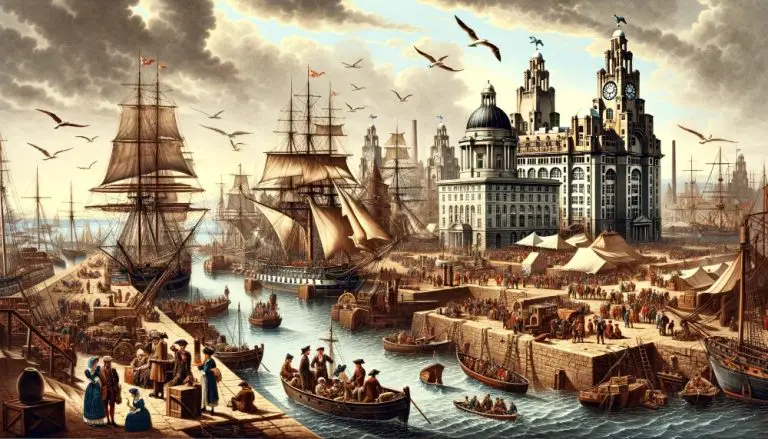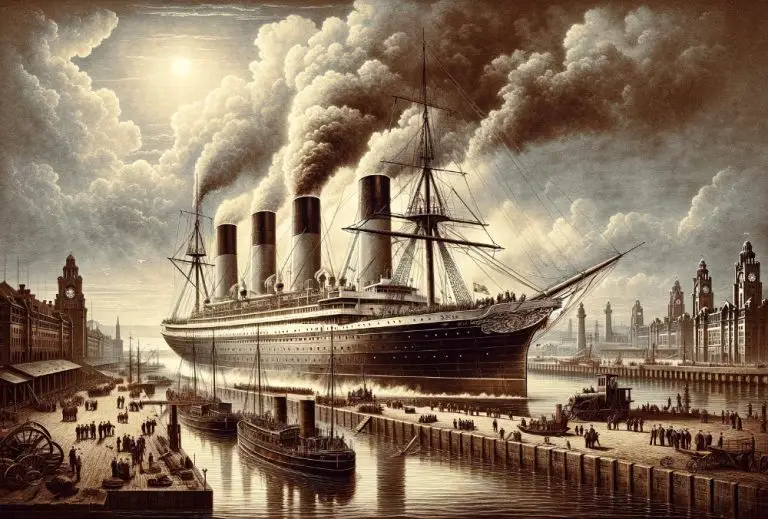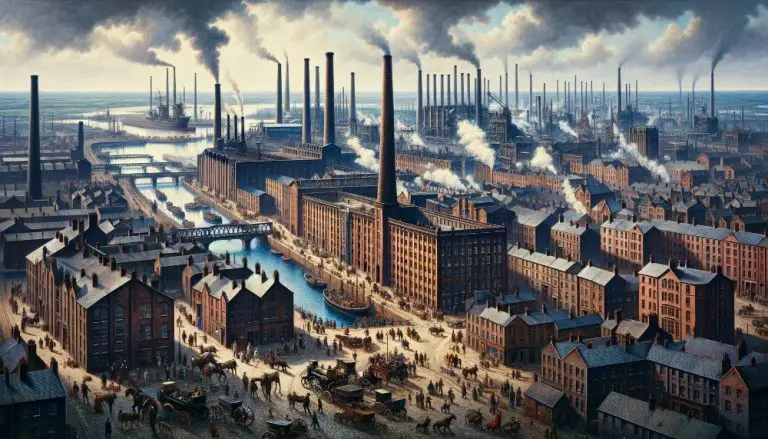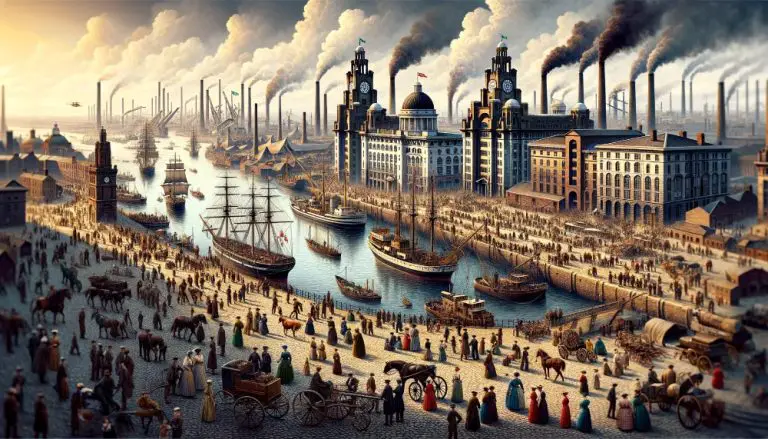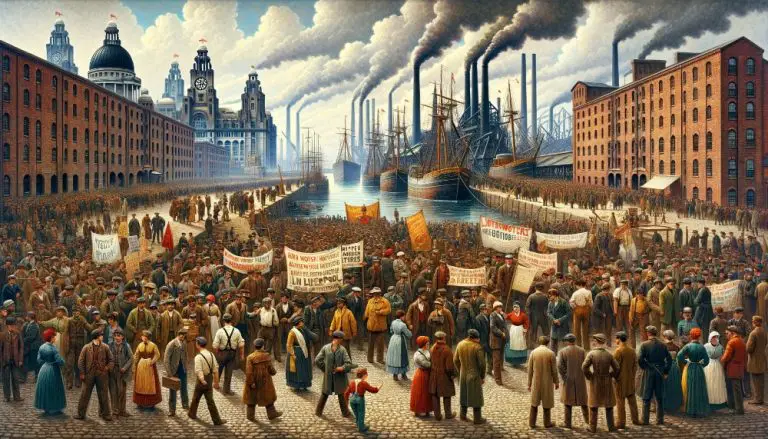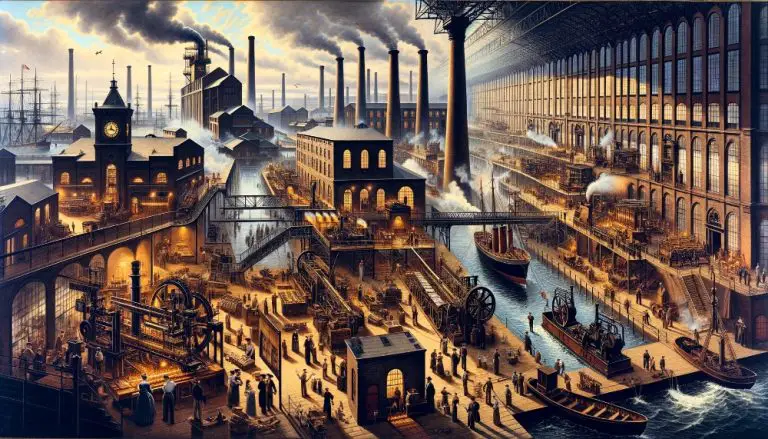The History of The Port of Liverpool and Maritime Trade During the Industrial Revolution
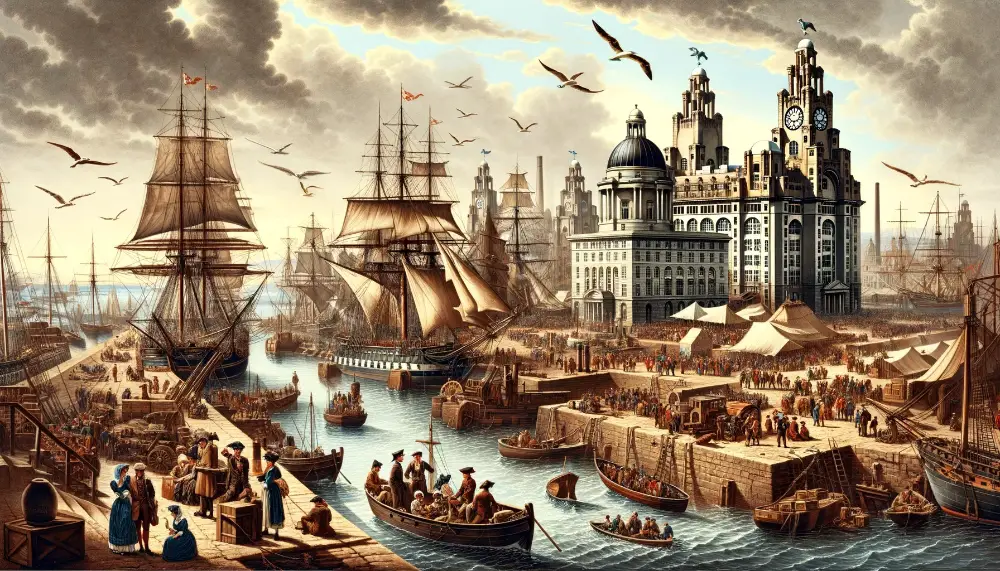
The Port of Liverpool has a rich history that stretches back to the Industrial Revolution. It played a pivotal role in the maritime trade of the time, contributing to the prosperity of Liverpool and the growth of the British Empire. During this transformative period, the port stood at the forefront of global trade, handling a diverse range of goods and connecting the city to markets around the world.
As one of the most advanced and efficient ports in the world, the Port of Liverpool facilitated the movement of goods, both export and import, on a massive scale. Its strategic location on the River Mersey allowed for easy access to the Atlantic Ocean, turning Liverpool into a major gateway for international trade. The port became a bustling hub, attracting merchants, sailors, and adventurers from all corners of the globe.
The success of the Port of Liverpool was closely intertwined with the developments of the Industrial Revolution. The revolution saw the rise of new technologies and methods of production that increased the demand for raw materials and the need for efficient transportation systems. Liverpool’s port played a crucial role in meeting these demands, becoming a crucial link in the global supply chain.
Throughout the Industrial Revolution, the Port of Liverpool continued to evolve and expand. The city’s extensive network of docks and warehouses grew in scale and sophistication, accommodating the growing volume of trade. The port became a melting pot of different cultures, as people from around the world arrived seeking new opportunities and a chance to be a part of Liverpool’s maritime legacy.
Today, the Port of Liverpool still stands as a testament to its history. While its role and operations have changed over time, the port remains an important hub for international trade and a symbol of Liverpool’s enduring connection to its maritime past.
Key Takeaways
- The Port of Liverpool played a crucial role in maritime trade during the Industrial Revolution.
- It was one of the most advanced and efficient ports in the world, handling a wide range of goods.
- The port contributed to the prosperity of Liverpool and the British Empire.
- Liverpool’s strategic location on the River Mersey made it a major gateway for international trade.
- The city’s port played a pivotal role in meeting the demands of the Industrial Revolution and connecting Liverpool to global markets.
The Rise of the Albert Docks
Designed by Jesse Hartley and officially opened in 1846, the Albert Docks marked a departure from traditional dock layouts. They featured a revolutionary system of interconnected warehouses and hydraulic cranes. The docks quickly became a symbol of Liverpool’s status as a major global port and played a pivotal role in the transatlantic trade and the British Empire’s colonial ventures.
The Albert Docks revolutionized the way trade and commerce functioned, introducing innovative architectural and logistical advancements. The interconnected warehouses and efficient hydraulic cranes created a seamless flow of goods, streamlining the processes of loading and unloading cargo. This groundbreaking system ensured the speedy and secure transfer of goods, making the Albert Docks an indispensable hub for international trade.
The strategic location of the Albert Docks, adjacent to the River Mersey, further enhanced their significance. Accessible to large ships and conveniently connected to Liverpool’s extensive network of canals, the docks facilitated the transportation of goods between different regions. The transatlantic trade thrived as Liverpool became a vital link between the continents, boosting the British Empire’s economic dominance.
Key Features of the Albert Docks:
- An interconnected system of warehouses that enabled efficient storage and transportation of goods.
- Hydraulic cranes that improved loading and unloading operations, increasing productivity.
- Strategic location adjacent to the River Mersey and connected to Liverpool’s canal network.
- Role as a major hub for transatlantic trade, contributing to the success of the British Empire.
| Features | Benefits |
|---|---|
| Interconnected warehouses and hydraulic cranes | Efficient storage and transportation of goods |
| Strategic location and canal access | Facilitated international trade and boosted economic dominance |
The construction of the Albert Docks marked a significant milestone in Liverpool’s history, solidifying the city’s reputation as a center of global trade and commerce. The revolutionary system introduced at the Albert Docks set the stage for the modernization of ports around the world, serving as a blueprint for future dock layouts and operations.
Decline and Abandonment
The golden era of the Albert Docks came to an end during the mid-20th century as the shipping industry evolved and containerization began. The dock’s outdated infrastructure was unable to accommodate larger cargo vessels, leading to its decline and eventual abandonment. By the 1970s, the once-thriving port was left abandoned, and the warehouses stood as silent reminders of Liverpool’s past glory.
Liverpool’s Role in the Industrial Revolution
Liverpool, with its distinct location on the mouth of the river Mersey, played a pivotal role in the industrial revolution and the development of maritime trade. As the leading port in the north of England, Liverpool’s industrial past is deeply intertwined with its rich history and unique characteristics.
Maritime development in Liverpool can be traced back to the 13th century when a group of monks established the first ferry over the Mersey, setting the foundation for future growth and prosperity. During the Industrial Revolution, Liverpool quickly rose to prominence as a hub of immigration, emigration, slavery, and global trade.
The city’s strategic location at the meeting point of shipping lanes enabled it to become a gateway for transatlantic trade, sustaining and expanding the British Empire. Liverpool’s distinctive position as a major trading port allowed it to establish strong connections with regions around the world, facilitating the exchange of goods, ideas, and cultures.
With its bustling docks and thriving maritime industry, Liverpool became synonymous with industrial prowess and economic prosperity. The city’s industrial heritage is a testament to its contribution to global trade, and it stands as a proud reminder of its past achievements.
The Industrial Revolution and Liverpool’s Impact
During the Industrial Revolution, Liverpool experienced rapid growth and became a center for various industries. The city’s docks, warehouses, and factories played a vital role in supporting the booming trade and manufacturing sectors.
As Liverpool evolved into a major industrial and commercial hub, it attracted skilled workers from all over the country and even overseas. The influx of immigrants contributed to the city’s cultural diversity and further fueled its industrial development.
“Liverpool’s role in the Industrial Revolution propelled it to the forefront of global trade, solidifying its position as a major maritime powerhouse.”
The Legacy of Liverpool’s Industrial Past
The industrial heritage of Liverpool is still visible today, with remnants of its maritime development scattered throughout the city. The iconic docklands, historic buildings, and architectural landmarks serve as a testament to Liverpool’s industrial past.
Furthermore, Liverpool’s distinctiveness as an industrial city has shaped its identity and cultural landscape. The resilience and entrepreneurial spirit of its residents have been fostered by the challenges and successes of the past.
| Key Elements of Liverpool’s Industrial Heritage | Significance |
|---|---|
| Docks and Warehouses | Symbolize Liverpool’s role as a major port and global trade center |
| Industrial Architecture | Reflects the innovative engineering and design during the Industrial Revolution |
| Cultural Diversity | Resulted from the migration of workers and contributed to Liverpool’s distinctive identity |
| Economic Impact | Shaped the city’s economy and established its reputation as an industrial powerhouse |
Today, Liverpool continues to embrace its industrial heritage while thriving as a modern, vibrant city. Its unique blend of historical significance, cultural diversity, and maritime legacy make it a remarkable destination for visitors and a source of pride for its residents.
Industrial Innovations in Liverpool
Liverpool’s industrial heritage encompasses more than its significant role in trade. The city was at the forefront of innovation in maritime architecture, dock technology, and warehouse construction. Its pioneering advancements were adopted by ports across the globe and revolutionized the shipping industry.
The shipbuilding industry in Liverpool was particularly prosperous, contributing to the city’s reputation as a maritime powerhouse. Initially focused on wooden ships, Liverpool transitioned to iron shipbuilding in the 19th century, a pivotal moment that propelled the industry forward.
The manufacturing sector in Liverpool played a crucial role in supporting the shipbuilding industry. Sailmakers, ropemakers, ship engine manufacturers, and nautical instrument manufacturers all thrived within the city, providing essential equipment and materials for the construction and operation of ships.
One of the key innovations that Liverpool introduced was the use of hydraulic cranes at its docks. These cranes revolutionized the loading and unloading of cargo, improving efficiency and speeding up trade operations. The practicality and effectiveness of these hydraulic cranes soon made them a standard feature in ports around the world.
“Liverpool’s innovative approach to maritime architecture, dock technology, and shipbuilding industry established it as a leader in the field, setting the standard for ports globally.”
In addition to technological advancements, Liverpool also made significant contributions to warehouse construction. The city pioneered innovative designs and layouts for warehouses, ensuring efficient storage and movement of goods. These advancements helped create organized and streamlined supply chains, improving the overall effectiveness of maritime trade.
The Impact of Liverpool’s Industrial Innovations
The industrial innovations in Liverpool had a profound impact on the global shipping and trade industry. The adoption of Liverpool’s maritime architecture, dock technology, and warehouse construction techniques led to increased efficiency and productivity in ports worldwide. The city’s shipbuilding industry set new standards for vessel construction, pushing the boundaries of engineering and design.
Furthermore, Liverpool’s industrial innovations facilitated the growth of international trade, enabling the movement of goods and raw materials on an unprecedented scale. The city’s contributions to maritime technology and infrastructure firmly cemented its position as a key player in the global trade network, contributing to the economic development of not only Liverpool but also the wider United Kingdom.
A Table Showcasing Liverpool’s Industrial Innovations
| Industrial Innovations | Impact |
|---|---|
| Hydraulic Cranes | Revolutionized cargo handling, improved efficiency, and facilitated faster trade operations. |
| Iron Shipbuilding | Transition from wooden ships to iron ships, leading to stronger and more durable vessels. |
| Manufacturing Support | Sailmakers, ropemakers, ship engine manufacturers, and nautical instrument manufacturers provided essential equipment and materials for ship construction. |
| Warehouse Construction | Innovative designs and layouts for efficient storage and movement of goods, ensuring organized supply chains. |
The Role of Liverpool in Water Transport
Prior to the development of railways, canals were the backbone of industrial England, and Liverpool played a central role in connecting towns and cities with bustling ports. The city was at the forefront of innovations in water transport, enabling the efficient movement of goods. These canals were vital in bringing foreign goods to English consumers and facilitating the export of English products to markets around the world.
Enrichment of Liverpool’s Industrial Heritage
Over the years, Liverpool’s industrial heritage has been enriched by various developments. One notable contribution was made by George Blackwell, Sons & Co, a Liverpool-based company that created ferrochrome, a ferroalloy used in the production of stainless steel. This Liverpool company effectively founded the ferrochrome industry, which is now a global business. Today, Liverpool is home to car manufacturing, a thriving retail and film industry, and continues to expand its port infrastructure.
New Materials for a Modern Era
The discovery of ferrochrome revolutionized the materials processing industry in Liverpool. By combining chromium with iron, George Blackwell, Sons & Co. created a new alloy that had superior corrosion resistance and strength, making it ideal for the production of stainless steel. This breakthrough opened up a world of possibilities in various sectors, including construction, automotive, and manufacturing.
As the demand for stainless steel grew, Liverpool’s industrial landscape transformed, attracting new businesses and investments. Today, the ferrochrome industry remains an integral part of Liverpool’s economy, contributing to its status as a leading industrial hub.
Liverpool’s Enduring Spirit
Through the Industrial Revolution, economic hardship, and war, Liverpool has maintained its distinctive identity and endured as a city known for its ingenuity and industry. Its history reflects the resilience of its population. Liverpool also holds a significant place in the English music industry, with its clubs and bars producing world-famous performers like the Beatles. The city’s enduring spirit can be seen in its diverse industries and ongoing contributions to various fields.
Liverpool’s Resilience
The enduring city of Liverpool has faced numerous challenges throughout its history, from economic struggles to the devastations of war. However, its community has shown remarkable resilience, bouncing back from adversity time and time again. This steadfastness is a testament to the indomitable spirit of the Liverpudlians, who refuse to let setbacks define them.
Ingenious Industries
Liverpool has long been recognized for its ingenuity and innovation. From the earliest days of the Industrial Revolution, the city’s industries played a vital role in driving economic growth and technological advancements. Liverpool’s shipbuilding and manufacturing sectors were at the forefront of innovation, contributing to the city’s reputation as a center of industry and enterprise.
Conclusion
In conclusion, the Port of Liverpool’s rich history has left an indelible mark on maritime trade, particularly during the Industrial Revolution. Liverpool’s industrial heritage, from its innovative maritime architecture to its thriving shipbuilding industry, is a testament to the city’s enduring spirit and its significant contribution to global trade.
The Port of Liverpool played a pivotal role in the growth of the British Empire and the prosperity of Liverpool itself. As one of the most advanced and efficient ports in the world, it handled a diverse range of goods, contributing to the city’s economic success. Over the years, the port faced both success and decline, but its transformation into the modern Albert Docks signifies the resilience and adaptability of Liverpool’s industrial heritage.
Today, the Albert Docks stand as a vibrant testament to Liverpool’s industrial past and offer a multitude of experiences for visitors and residents alike. The area’s museums and galleries provide insight into the city’s maritime history, while its dining and entertainment options offer a taste of contemporary Liverpool. The rejuvenation project that converted the iconic warehouses into shops, offices, restaurants, and museums has breathed new life into the area, making it a must-visit destination for those seeking to explore Liverpool’s history and culture.
FAQ
What role did the Port of Liverpool play in maritime trade during the Industrial Revolution?
The Port of Liverpool played a crucial role in maritime trade during the Industrial Revolution. It was one of the most advanced and efficient ports in the world, handling a wide range of goods and contributing to the prosperity of Liverpool and the British Empire.
When were the Albert Docks built and what made them revolutionary?
The Albert Docks were designed by Jesse Hartley and officially opened in 1846. They featured a revolutionary system of interconnected warehouses and hydraulic cranes, which marked a departure from traditional dock layouts and quickly became a symbol of Liverpool’s status as a major global port.
What led to the decline and eventual abandonment of the Albert Docks?
The golden era of the Albert Docks came to an end during the mid-20th century when the shipping industry evolved and containerization began. The dock’s outdated infrastructure was unable to accommodate larger cargo vessels, leading to its decline and eventual abandonment.
How were the Albert Docks rejuvenated and transformed into a modern cultural and commercial center?
In the 1980s, a visionary rejuvenation project began to transform the derelict Albert Docks. Extensive restoration work was undertaken to preserve the historical integrity of the site. The iconic warehouses were converted into shops, offices, restaurants, and museums, breathing new life into the area.
What are the key features of the modern Albert Docks?
The modern Albert Docks are a vibrant showcase of Liverpool’s rich heritage and contemporary appeal. They offer a range of experiences, including museums and galleries like the Merseyside Maritime Museum and Tate Liverpool art gallery. Visitors can also enjoy a variety of dining and entertainment options, shopping opportunities, and the docks host numerous events and festivals throughout the year. Additionally, recent developments have added residential apartments, allowing people to live alongside the historic waterfront.
What was Liverpool’s role in the Industrial Revolution?
Liverpool’s unique location on the mouth of the river Mersey, at the meeting point of shipping lanes, made it the leading port in the north of England. The city played a vital role in sustaining and expanding the British Empire through immigration, emigration, slavery, and global trade. Liverpool’s maritime development dates back to the 13th century and has shaped its distinctive identity as a city with a proud industrial heritage.
What were some of the industrial innovations in Liverpool?
Liverpool was a center of innovation in maritime architecture, dock facilities, and warehouse construction. It was also home to a thriving shipbuilding industry, producing wooden ships and transitioning to iron ships in the 19th century. The city housed various manufacturers involved in supporting the ships, such as sailmakers, ropemakers, ship engine manufacturers, and nautical instrument manufacturers.
How did Liverpool contribute to water transport during the Industrial Revolution?
Prior to the development of railways, canals were the backbone of industrial England, and Liverpool played a central role in connecting towns and cities with bustling ports. The city was at the forefront of innovations in water transport, enabling the efficient movement of goods. These canals were vital in bringing foreign goods to English consumers and facilitating the export of English products to markets around the world.
How has Liverpool’s industrial heritage been enriched over the years?
Liverpool’s industrial heritage has been enriched by various developments over the years. One notable contribution was made by a Liverpool-based company called George Blackwell, Sons & Co, which effectively founded the ferrochrome industry, now a global business. Today, Liverpool is home to car manufacturing, a thriving retail and film industry, and continues to expand its port infrastructure.
What is Liverpool’s enduring spirit?
Liverpool has maintained its distinctive identity and endured as a city known for its ingenuity and industry throughout the years. Its history reflects the resilience of its population. The city’s enduring spirit can be seen in its diverse industries and ongoing contributions to various fields. Liverpool also holds a significant place in the English music industry, with its clubs and bars producing world-famous performers like the Beatles.
Source Links
- https://inostalgia.co.uk/local-history/liverpool-albert-docks/
- http://www.clickliverpool.com/features/31760-liverpools-industrial-heritage/
- https://www.visitliverpool.com/things-to-do/attractions-in-liverpool/maritime-and-history/
- The History Behind Liverpool’s You’ll Never Walk Along - February 16, 2024
- The History of Everton FC - February 16, 2024
- The History of Liverpool FC - February 16, 2024

